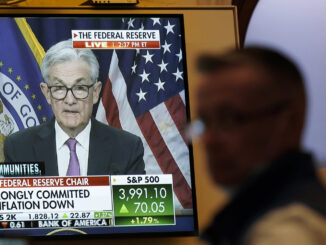
The JGB bond market, which has long been the pinnacle of MMT lunacy and a testament to a dying financial system, may be on its way out for good (read “One Bank Makes A Stunning Discovery: The Bank Of Japan’s YCC Is Broken And Soon The Entire JGB Market Will Cease To Exist“) but it still has a few tricks up its sleeve.
Taking a page right out of the batshit insane California (and liberal) playbook, the Japanese government on Friday unveiled 29.1 trillion yen ($197BN) in fresh spending to – drumroll – ease the impact on consumers of something Japan has not seen for decades, i,e., soaring inflation, and something it has seen (but not to this extent) a collapsing yen.
The cartoonish irony, of course, is that Prime minister Fumio Kishida unveiled the stimulus package, which includes subsidized electricity and gas bills for households and coupons for pregnant women, just hours after Bank of Japan governor Kuroda ruled out any early rise in interest rates – despite the highest Tokyo CPI print since 1989 – and once again boosted the amount of QE the BOJ would have to do to keep bond yields from soaring higher and vowing he is “not thinking at all of stopping policy to spur prices”, thus sending the yen tumbling once again (and just days after his own BOJ spent tens of billions of dollars to prevent the yen from cratering).
Describing the absolute lunacy out of Japan this morning, Nomura’s Charlie McElligott pulled no punches:
BoJ goes “hilarious mode” despite a new high in HOT CPI (Tokyo inflation at highs since ’89), doubling down on easing & YCC and BOOSTING their bond purchase notionals mid-quarter for the first time, while releasing the following GEMS:
*KURODA: DON’T EXPECT RATE HIKE OR EXIT ANYTIME SOON*KURODA: NEED TO FIRMLY SUPPORT ECONOMY WITH MONETARY EASING*KURODA: YCC IS A METHOD OF EASING, DOESN’T CAUSE WEAK YEN*KURODA: NOT THINKING AT ALL OF STOPPING POLICY TO SPUR PRICES*KURODA: MONETARY POLICY NOT TARGETING FX*BOJ BOOSTS BOND PURCHASE PLAN MID-QUARTER FOR FIRST TIME*BOJ SEES FY2022 CORE CPI AT 2.9% VS 2.3% PREVIOUSLY…And all while Japan’s government on Friday too unveiled a new stimulus plan spending upwards of $490B in totality to ease inflation LOLLLLLLLLLL
But wait, it gets better: the prime minister said the spending – which in addition to the $200BN in government funded stimulus is a $490BN total check – was expected to bring down Japan’s consumer inflation rate by more than 1.2 percentage points, which of course will never happen; instead what will happen is that the massive stimulus – which would have been equivalent to almost $1 trillion in the US – will only push prices higher, and since the BOJ will have to monetize it all, the BOJ is effectively printing money to offset the inflationary impact of printing money!
While Japan’s headline inflation rate (and recall that Japan has come up with like 10 different measures of CPI to convince people that its monetary policy is actually worked), at 3% in September, is much lower than price rises in the US and Europe, Kishida has come under pressure to take tougher measures to tackle higher living costs amid a sharp fall in his public approval ratings. After all, Japan has lived under deflation for the past 30 years and is not used to any price increases (as for Kuroda’s hope that this will spark some benign wage-price spiral, good luck).
Amid this lunacy, Japanese authorities have carried out at least two interventions to prop up the yen, which has fallen to 32-year lows because of the widening gulf between the BoJ’s super-dovish policy – which in turn is the result of the country’s MMT strategy of monetizing all the debt and deficit – and tightening by most other big central banks. Indeed, while the ECB on Thursday raised interest rates to their highest level since 2009, the BoJ kept overnight rates on hold at -0.1 per cent and continued to cap 10-year bond yields at about zero per cent.
The widely expected BoJ decision, made at a time of exceptional volatility in currency markets, initially sent the yen slightly higher to ?146.21 to the dollar. But the currency later fell to below ?147 after Kuroda made clear he was not considering early action to raise interest rates.
“We are getting closer to achieving our 2 per cent [core consumer inflation] target,” Kuroda said, but added: “We are not thinking of a rate hike or an exit anytime soon.”
Translation: the USDJPY is going right back to 150, where the BOJ will have to intervene again and again… until it runs out of US reserves at which point it is game over and hyperinflation – in the form of currency collapse – finally arrives.
There was more: with the government set to spend hundreds of billions more, Japan’s central bank also announced it would increase the frequency of its bond-buying in November to defend its control of the yield curve, even though the policy of suppressing longer term interest rates has effectively choked off trading in the 10-year JGB market. As of this moment, the BOJ owns more than half of all JGBs in circulation.
To justify the lack of a shift in monetary policy, the central bank sharply upgraded its core CPI forecast to 2.9% from the 2.3% projected in July for the year ending March 2023, while lowering its real GDP forecast to growth of 2% from 2.4% (read stagflationary recession). The BoJ forecast did not take into account the new stimulus spending. But while this would have been sufficient to boost rates, the central bank also said it expects inflation to fall to 1.6% in both fiscal 2023 and 2024.
Kuroda has frequently argued that underlying demand in the economy remained too weak for it to shift to policy tightening.
Of course, the economy has nothing to do with the BOJ’s policy; instead the central bank is stuck in deficit monetization mode – a core tenet of MMT – until the bitter end, which at this rate may be just a few short years away… or maybe even months, because the BOJ’s failed monetary policy is increasingly becoming a political issue. While so far, Kishida has expressed support for the BoJ policy, the FT reports that some analysts said the central bank might come under increasing political pressure as the government shifts its focus to tackling rising living costs.
“With the yen becoming a political issue and with the Kishida administration’s approval rate falling, it is questionable how long it can tolerate a situation where the government is carrying out interventions to stem the yen’s fall while the BoJ’s monetary policy is facing in a completely different direction,” said Barclays Japan economist Tetsufumi Yamakawa,



